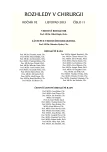Reconstruction of complex abdominal wall defects using the component separation technique
Authors:
J. Kulhánek 1,2; O. Měšťák 1
Authors‘ workplace:
Klinika plastické chirurgie, Nemocnice Bulovka, přednosta: Doc. MUDr. J. Měšťák, CSc.
1; Chirurgické oddělení, Nemocnice Na Františku, primář: MUDr. D. Erhart
2
Published in:
Rozhl. Chir., 2013, roč. 92, č. 11, s. 640-643.
Category:
Original articles
Overview
Introduction:
Reconstruction of complex abdominal wall defects is among the most demanding procedures in reconstructive surgery. Introduction of the method of component separation represents the most significant advance in the care of these patients. We present our experience with the component separation technique on a series of 44 patients.
Materials and methods:
We retrospectively reviewed patients operated on between 2009 and 2012. The inclusion criterion was the use of the component separation technique in the treatment of abdominal wall defect. The scoring criteria were recurrent hernia, wound hematoma, wound infection, skin necrosis and secondary healing.
Results:
We operated on 44 patients in the above period. The etiology of the defects was most frequently hernia in the scar after midline laparotomy (n = 29; 66%) and after incision across the epigastrium for total gastrectomy (n = 3; 7%). The other defects (n = 12; 27%) were caused by a wide diastasis of the abdominal rectus muscles (width 8–10 cm). The most common complication was a hematoma in the lateral part of the wound which occurred in 7 patients (16%). We did not detect any hernia recurrence in the original abdominal wall defects.
Conclusion:
The method of components separation allows us to stitch the edges of the full-thickness abdominal wall to each other, even in cases of large hernias. The introduction of this technique into practice has reduced the risk of recurrence of large hernias without a significant increase in postoperative complications.
Key words:
component separation – hernia – biologic mesh
Sources
1. Ventral Hernia Working Group – Breuing K, Butler CE, Ferzoco S, Franz M, Hultman CS, et al. Incisional ventral hernias: review of the literature and recommendations regarding the grading and technique of repair. Surgery 2010;148:544–58.
2. Blatnik J, Jin J, Rosen M. Abdominal hernia repair with bridging acellular dermal matrix-an extensive hernia sac. American journal of surgery 2008;196:47–50.
3. Ramirez OM, Ruas E, Dellon AL. “Components separation” method for closure of abdominal-wall defects: an anatomic and clinical study. Plast Reconstr Surg 1990;86:519–26.
4. Clarke JM. Incisional hernia repair by fascial component separation: results in 128 cases and evolution of technique. American journal of surgery 2010;200:2–8.
5. Eriksson A, Rosenberg J, Bisgaard T. Surgical treatment for giant incisional hernia: a qualitative systematic review. 2013 Mar 2. [Epub ahead of print] PubMed PMID: 23456151.
6. Patel KM, Nahabedian MY, Gatti M, Bhanot P. Indications and outcomes following complex abdominal reconstruction with component separation combined with porcine acellular dermal matrix reinforcement. Annals of plastic surgery 2012;69:394–8.
7. Novitsky YW, Rosen MJ. The biology of biologics: basic science and clinical concepts. Plast Reconstr Surg 2012;130(5 Suppl 2):9S–17S.
8. Mudge M, Hughes LE. Incisional hernia: a 10 year prospective study of incidence and attitudes. The British journal of surgery 1985;72:70–1.
9. Höer J, Lawong G, Klinge U, Schumpelick V. Factors influencing the development of incisional hernia. A retrospective study of 2,983 laparotomy patients over a period of 10 years]. Der Chirurg; Zeitschrift fur alle Gebiete der operativen Medizen 2002;73:474–80.
10. Ghazi B, Deigni O, Yezhelyev M, Losken A. Current options in the management of complex abdominal wall defects. Annals of plastic surgery 2011;66:488–92.
11. Mazzocchi M, Dessy LA, Sorvillo V, Di Ronza S, Scuderi N. A study of intraabdominal pressure modification in “component separation” technique for repair of incisional hernia. Ann Ital Chir 2010;81:433–7.
12. Joels CS, Vanderveer AS, Newcomb WL, Lincourt AE, Polhill JL, et al. Abdominal wall reconstruction after temporary abdominal closure: A ten-year review. Surgical innovation 2006;13:223–30.
13. Malik K, Bowers SP, Smith CD, Asbun H, Preissler S. A case series of laparoscopic components separation and rectus medialization with laparoscopic ventral hernia repair. J Laparoendosc Adv Surg Tech A 2009;19:607–10.
14. Milburn ML, Shah PK, Friedman EB, Roth JS, Bochicchio GV, et al. Laparoscopically assisted components separation technique for ventral incisional hernia repair. Hernia 2007;11:157–61.
15. Rosen MJ, Jin J, McGee MF, Williams C, Marks J, et al. Laparoscopic component separation in the single-stage treatment of infected abdominal wall prosthetic removal. Hernia 2007;11: 435–40.
16. Tong WMY, Hope W, Overby DW, Hultman CS. Comparison of outcome after mesh-only repair, laparoscopic component separation, and open component separation. Annals of plastic surgery 2011;66:551–6.
17. Harth KC, Rosen MJ. Endoscopic versus open component separation in complex abdominal wall reconstruction. American journal of surgery 2010;199:342–6–discussion 346–7.
Labels
Surgery Orthopaedics Trauma surgeryArticle was published in
Perspectives in Surgery

2013 Issue 11
- Metamizole vs. Tramadol in Postoperative Analgesia
- Metamizole at a Glance and in Practice – Effective Non-Opioid Analgesic for All Ages
- Current Insights into the Antispasmodic and Analgesic Effects of Metamizole on the Gastrointestinal Tract
Most read in this issue
- Chest drainage systems and the complications associated with drainage.
- Chest drainage methods
- Chest drainage – physiological and pathophysiological aspects and indications
- Reconstruction of complex abdominal wall defects using the component separation technique
